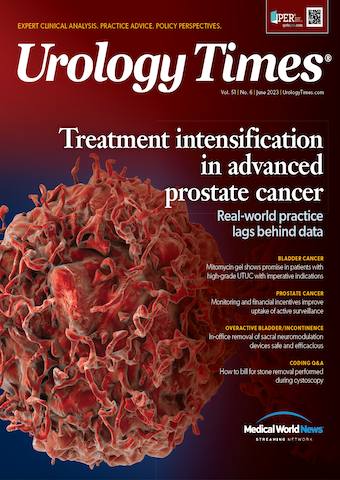Publication
Article
Urology Times Journal
Monitoring, feedback, and financial incentives improve uptake of active surveillance
Author(s):
"The study demonstrated that AS rate in the MUSIC cohort, which in 2014 had been lower than in the SEER cohort, increased rapidly, from approximately 20% in 2014 to nearly 50% in 2019, whereas the SEER cohort showed only a modest increase," writes Badar M. Mian, MD.
Badar M. Mian, MD

During the past 10 to 15 years, active surveillance (AS) has been recommended in men with low-risk prostate cancer (PCa), and more recently, it has been selectively recommended in those with favorable intermediate-risk disease. Although its utilization is increasing, AS remains underused in men with favorable risk (ie, low-risk and favorable intermediate-risk). Although several predictors of AS utilization have been identified, data on how to increase it are limited.
A report from the Michigan Urologic Surgery Improvement Collaborative (MUSIC) describes the results of a previously deployed initiative to define and implement quality metrics and improve AS utilization rates in patients with favorable risk PCa.1 The authors compared AS rates from the MUSIC registry with those from the national Surveillance, Epidemiology, and End Results (SEER) program.
More than 90% of the urologists practicing in Michigan have a data abstractor who provides MUSIC with practice-level data on AS. AS approach was confirmed if patient records explicitly stated that it is the primary management option and that the patient did not undergo definitive therapy within a year of diagnosis. In 2014, MUSIC developed a standardized workflow for the management of all patients with low-risk PCa and selected patients with intermediate-risk PCa. It established quality metrics to measure the progress of MUSIC urologists and provided them with feedback on their management of men with favorable-risk disease. Among other things, this initiative evaluated performance in terms of the use of AS and confirmatory tests in patients with low-risk PCa. When the collaborative meets specific performance targets, participating urologists receive higher reimbursement (up to 105% of standard fee) from Blue Cross Blue Shield of Michigan (BCBSM).
Vince et al identified 6300 patients treated within the MUSIC collaborative, including 3608 with low-risk and 2692 with favorable intermediate-risk PCa. The SEER cohort included 81,216 men nationwide, of whom 36,101 had low-risk PCa and 45,115, favorable intermediate-risk PCa. After the MUSIC initiative was implemented in June 2014, MUSIC patients with favorable-risk disease were twice as likely to be managed with AS (OR 2.14; 95% CI, 1.87-2.45; P<.001). In the SEER cohort, those who received a diagnosis after June 2014 were 11% more likely to be managed with AS (OR 1.11; 95% CI, 1.05-1.16; P<.001).
Predictors of AS use were similar in the MUSIC and SEER cohorts and included Gleason score, clinical stage prostate-specific antigen level, and number of positive cores. The increase in AS use was significantly higher in the MUSIC than in the SEER cohort (interaction OR 1.95; 95% CI 1.70-2.23; P<.001).
The study demonstrated that AS rate in the MUSIC cohort, which in 2014 had been lower than in the SEER cohort, increased rapidly, from approximately 20% in 2014 to nearly 50% in 2019, whereas the SEER cohort showed only a modest increase. It should be noted that MUSIC data were available until 2019, whereas SEER data extended only to 2016. The authors conducted a statistical projection of expected AS rates in the SEER cohorts through 2019. They projected an unexpectedly flat AS rate in the SEER cohort whereas other reports have demonstrated that awareness campaigns and the greater use of confirmatory tests have increased nationwide AS utilization. This statistical methodology overestimates the differences between AS increase in the 2 cohorts and should be interpreted with caution.
The effect of financial incentives (higher reimbursement) on increased adoption of AS is unclear. Data-driven feedback to urologists about their management of low-risk PCa compared with that of local and national peers and the greater availability of multiparametric prostate MRI may have improved the rate of AS adoption, given that the Hawthorne effect is a powerful, proven modifier of behavior.
The MUSIC environment is unique because BCBSM dominates the insurance market in the state and has funded the collaborative for cost containment as well as quality improvement. This scenario is unlikely to be replicable in most other regions. My attempts to form quality improvement partnerships with regional payers involving multiparametric MRI and post-surgical opioid prescriptions were met with variable degrees of enthusiasm. However, it is entirely possible that group practices, hospitals, and/or urology departments can employ self-auditing methodology and provide clinician feedback that leads to behavior modification and achieves the desired metrics without the need for a major and expensive initiative.
The MUSIC study raises another interesting question. Should physicians need financial incentives to do the right thing even when robust data about its advisability are available? Let’s hope not. It’s probably best not to ask for too many carrots from payors for some fundamentally appropriate medical decision-making lest sticks be soon to follow for inappropriate decision-making.
Reference
1. Vince RA Jr, Sun Y, Mahal B, et al. The impact of a statewide active surveillance initiative: a roadmap for increasing active surveillance utilization nationwide. Eur Urol. 2023;83(4):307-310. doi:10.1016/j.eururo.2022.05.028






























